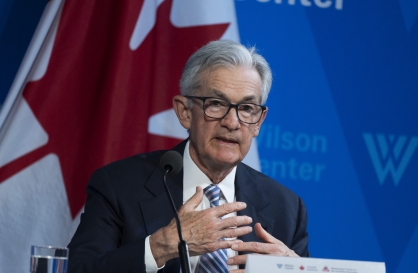Allies explore US strategic assets’ constant stay on peninsula
By Korea HeraldPublished : Oct. 20, 2016 - 17:00
Seoul and Washington on Thursday explored ways to permanently station US strategic assets such as a nuclear bomber and top-notch warplane on the peninsula as part of efforts to boost their deterrence and better respond to North Korea’s evolving threats.
The annual Security Consultative Meeting between South Korean Defense Minister Han Min-koo and US Defense Secretary Ash Carter came one day after their joint meeting involving Foreign Minister Yun Byung-se and Secretary of State John Kerry. After the “two-plus-two” talks, they unveiled plans to launch a vice-ministerial consultative body tasked with studying how to improve the execution of the US’ extended deterrence.
The annual Security Consultative Meeting between South Korean Defense Minister Han Min-koo and US Defense Secretary Ash Carter came one day after their joint meeting involving Foreign Minister Yun Byung-se and Secretary of State John Kerry. After the “two-plus-two” talks, they unveiled plans to launch a vice-ministerial consultative body tasked with studying how to improve the execution of the US’ extended deterrence.

The consecutive sessions appear to be intended to defuse growing anxiety over the US’ security safeguard here following the communist state’s fourth and fifth atomic experiments this year.
Many lawmakers and experts have since been calling for bringing back US tactical nuclear weapons, withdrawn from the peninsula in the 1990s, going beyond a one-off dispatch of fighter planes and other weapons upon Pyongyang’s provocations. Some even argue that Seoul should build its own deterrence strategy involving a nuclear-powered submarine or bombs if necessary.
Ahead of the SCM, the two countries’ defense agencies are believed to have been looking into the possibility for a standing deployment of the B-1B bomber and Aegis-equipped destroyer.
“I assured the minister of our commitment, the United States’ commitment, to defend South Korea through a robust combined defense posture and through extended deterrence, including the US nuclear umbrella, conventional strike and missile defense capabilities,” Kerry said during a joint press conference with Yun.
Yun also reaffirmed Seoul’s commitment to a nuclear-free peninsula, adding that the envisioned Extended Deterrence Strategy and Consultation Group will take on not only military agendas but also the strategic and policy-wise dimensions.
“It’s time to further step up our efforts to bolster international pressure over North Korea’s nuclear and missile threats which are becoming more dangerous than ever, rather than talking about our policy as one of the most exemplary non-nuclear nations,” the minister said.
At the outset of the four-way meeting, the defense chiefs warned Pyongyang against further provocations. The North fired another intermediate ballistic missile earlier Thursday in a fresh show of force, though it appears to have failed.
Han highlighted the grave challenges posed by the regime, likening it to a “blade to our throat.”
The defense chiefs’ meeting is part of their drive to “modernize our alliance to seize new opportunities and to address evolving threats,” Carter said, stressing the need for a “credible” deterrence.
“Make no mistake,” the defense secretary said. “Any attack on America or our allies will not only be defeated, but also any use of nuclear weapons will be met with an overwhelming and effective response.”
With the UN Security Council working on crafting new sanctions over last month’s underground detonation, the US is focusing on plugging a “loophole” and preventing “abuse” of the existing resolution that allows the North’s coal exports for livelihood purposes, Kerry said.
While not currently in the making, secondary sanctions remains “not off the table as an option,” he added, displaying the willingness to increase pressure on the regime to change course.
“We hope that people will make wiser choices and there will be a greater level of enforcement,” the secretary said. “We’ll see where we go over the course -- our first choice is to have a full measure of cooperation.”
In another development, the two countries introduced a separate body designed to work to enhance the isolated country’s human rights situations.
During its inaugural meeting on Oct. 4, the gathering discussed ways to share information and expand cooperation on promoting global awareness over the rampant rights breaches, the issue of North Korean overseas workers and how to hold the regime accountable in the future, Seoul’s Foreign Ministry said.
In a joint statement, they lambasted the Kim Jong-un regime for diverting resources to military programs while aggravating the hardship of its people.
“The plan shows the sides’ resolve to take a holistic approach toward the nuclear, human rights and other North Korea issues overall in line with growing momentum for the international community’s responses,” the ministry said in a statement.
By Shin Hyon-hee (heeshin@heraldcorp.com)
Many lawmakers and experts have since been calling for bringing back US tactical nuclear weapons, withdrawn from the peninsula in the 1990s, going beyond a one-off dispatch of fighter planes and other weapons upon Pyongyang’s provocations. Some even argue that Seoul should build its own deterrence strategy involving a nuclear-powered submarine or bombs if necessary.
Ahead of the SCM, the two countries’ defense agencies are believed to have been looking into the possibility for a standing deployment of the B-1B bomber and Aegis-equipped destroyer.
“I assured the minister of our commitment, the United States’ commitment, to defend South Korea through a robust combined defense posture and through extended deterrence, including the US nuclear umbrella, conventional strike and missile defense capabilities,” Kerry said during a joint press conference with Yun.
Yun also reaffirmed Seoul’s commitment to a nuclear-free peninsula, adding that the envisioned Extended Deterrence Strategy and Consultation Group will take on not only military agendas but also the strategic and policy-wise dimensions.
“It’s time to further step up our efforts to bolster international pressure over North Korea’s nuclear and missile threats which are becoming more dangerous than ever, rather than talking about our policy as one of the most exemplary non-nuclear nations,” the minister said.
At the outset of the four-way meeting, the defense chiefs warned Pyongyang against further provocations. The North fired another intermediate ballistic missile earlier Thursday in a fresh show of force, though it appears to have failed.
Han highlighted the grave challenges posed by the regime, likening it to a “blade to our throat.”
The defense chiefs’ meeting is part of their drive to “modernize our alliance to seize new opportunities and to address evolving threats,” Carter said, stressing the need for a “credible” deterrence.
“Make no mistake,” the defense secretary said. “Any attack on America or our allies will not only be defeated, but also any use of nuclear weapons will be met with an overwhelming and effective response.”
With the UN Security Council working on crafting new sanctions over last month’s underground detonation, the US is focusing on plugging a “loophole” and preventing “abuse” of the existing resolution that allows the North’s coal exports for livelihood purposes, Kerry said.
While not currently in the making, secondary sanctions remains “not off the table as an option,” he added, displaying the willingness to increase pressure on the regime to change course.
“We hope that people will make wiser choices and there will be a greater level of enforcement,” the secretary said. “We’ll see where we go over the course -- our first choice is to have a full measure of cooperation.”
In another development, the two countries introduced a separate body designed to work to enhance the isolated country’s human rights situations.
During its inaugural meeting on Oct. 4, the gathering discussed ways to share information and expand cooperation on promoting global awareness over the rampant rights breaches, the issue of North Korean overseas workers and how to hold the regime accountable in the future, Seoul’s Foreign Ministry said.
In a joint statement, they lambasted the Kim Jong-un regime for diverting resources to military programs while aggravating the hardship of its people.
“The plan shows the sides’ resolve to take a holistic approach toward the nuclear, human rights and other North Korea issues overall in line with growing momentum for the international community’s responses,” the ministry said in a statement.
By Shin Hyon-hee (heeshin@heraldcorp.com)
-
Articles by Korea Herald








![[Today’s K-pop] BTS pop-up event to come to Seoul](http://res.heraldm.com/phpwas/restmb_idxmake.php?idx=644&simg=/content/image/2024/04/17/20240417050734_0.jpg&u=)
![[Graphic News] More Koreans say they plan long-distance trips this year](http://res.heraldm.com/phpwas/restmb_idxmake.php?idx=644&simg=/content/image/2024/04/17/20240417050828_0.gif&u=)







![[KH Explains] Hyundai's full hybrid edge to pay off amid slow transition to pure EVs](http://res.heraldm.com/phpwas/restmb_idxmake.php?idx=652&simg=/content/image/2024/04/18/20240418050645_0.jpg&u=20240419100350)

